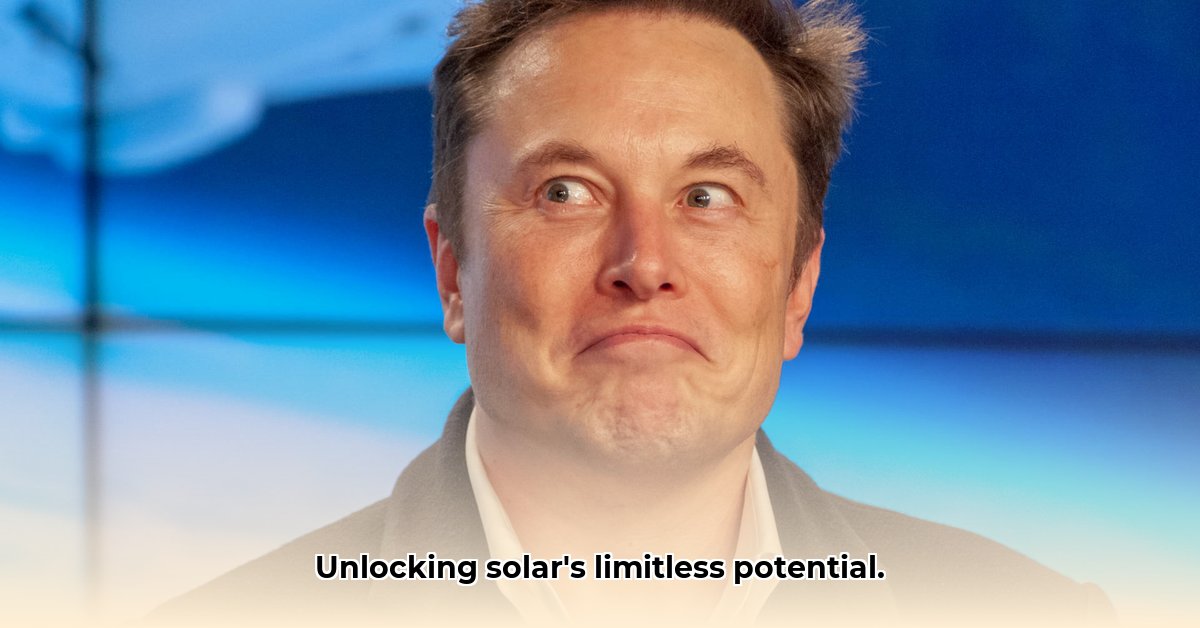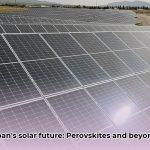Elon Musk’s vision of a sun-powered future involves harnessing solar energy on a grand scale. This article explores the feasibility of this vision, examining Tesla’s contributions, potential challenges, and the societal impacts of a global shift to solar energy. Realizing solar energy’s full potential demands technological advancements, policy changes, and strategic planning. For insights into future solar costs, see this analysis on future solar costs.
Unlocking Solar Energy’s Potential While Tackling Challenges
Harnessing solar energy presents incredible opportunities, but significant technical and regulatory hurdles must be addressed for widespread adoption. Advancements in energy storage and grid infrastructure are key to unlocking the full potential of this renewable resource.
Tapping the Sun’s Limitless Energy: Powering the Planet Sustainably
The sun emits more energy than humanity could ever use. A single square mile of a solar farm can generate enough power for a large city, demonstrating solar energy’s remarkable power density. Efficiently capturing and storing this energy unlocks limitless possibilities for sustainable power solutions. Tesla’s role extends beyond electric cars, with its solar panels quietly harvesting the sun’s energy.
Tesla’s Pivotal Role: Revolutionizing Energy Storage and Distribution
Tesla plays a crucial role in the solar energy sector. Their solar panels are becoming increasingly common on homes and businesses, capturing energy from the sun. Energy storage systems, like the Powerwall and Powerpack, store this solar energy for use when the sun is not shining. Energy storage is crucial for addressing the intermittency inherent in solar power generation.
Overcoming Obstacles: Addressing Intermittency and Enhancing Grid Integration
Transitioning to a fully solar-powered world presents significant challenges. Energy storage remains a major hurdle; affordable and efficient batteries for large-scale use are essential. Integrating solar panels into existing power grids requires substantial upgrades, as current systems are not designed for the fluctuating nature of solar energy. Smart grids will be essential.
Policy and Global Collaboration: Paving the Way for Wider Solar Energy Adoption
Government policies are vital for supporting solar energy adoption, including incentives such as tax breaks, streamlined permitting processes, and investments in grid modernization. International cooperation is also necessary to standardize the solar industry and streamline global efforts. This collaboration is essential for fostering innovation and ensuring widespread access to solar technology.
Economic Viability and Societal Impact: Ensuring Equitable Energy Access
The declining cost of solar power makes it increasingly competitive with fossil fuels, enhancing its economic viability. Ensuring equitable access to clean energy is critical to distributing the benefits of solar energy globally, not just in affluent regions. Making solar energy accessible to all promotes sustainable development and reduces global inequalities.
Balancing Vision with Reality: Charting a Course for Sustainable Progress
Musk’s vision is ambitious, yet achievable. Technological advancements, supportive policies, and strong international collaboration are essential for realizing this vision. While a fully solar-powered world may be distant, the journey toward it is crucial for creating a cleaner, more sustainable future. Emerging technologies promise to accelerate this transition to solar energy.
Overcoming Grid Limitations for Large-Scale Solar Energy Adoption
Elon Musk’s vision for a solar-powered future is inspiring. However, managing solar energy efficiently requires significant grid improvements.
Solar Energy’s Untapped Potential and Its Impact on the Energy Grid
Solar energy is a clean and abundant resource, but its intermittency remains a primary challenge. Robust storage systems are needed to address this fluctuation and meet the solar energy demand reliably.
Tesla’s Role in Driving the Solar Energy Revolution and Shaping Market Strategies
Tesla manufactures solar panels and Powerwalls, aiming to address challenges at the grid level. Tesla’s innovative approach helps overcome grid limitations for large-scale solar energy adoption.
Technological Hurdles and Solutions for Solar Energy Efficiency
Key technological hurdles need addressing for more effective use of solar energy:
- Energy Storage: Batteries can store excess solar energy, with pumped hydro and thermal storage offering promising alternatives. More research and deployment are crucial.
- Grid Integration: Integrating solar power requires smart grids with advanced control systems. This integration can be expensive but is essential for stability.
- Cost-Effectiveness: The upfront investment for solar projects remains significant. Innovative financing models are vital for broader adoption.
Policy and Regulatory Frameworks for Solar Energy Expansion
Government policies support solar adoption through financial incentives, streamlined regulations, and research grants. International cooperation is also necessary, as a global shift requires coordinated action.
Economic and Societal Impacts: Benefits of Solar Energy
Transitioning to solar energy offers significant economic opportunities. While it creates green jobs, it requires strategic investment in new infrastructure and training. Ensuring equitable access to clean energy is also a crucial consideration.
Maximizing Solar Power: Strategic Initiatives for Industry Leaders
- Significant advancements in energy storage technologies are required.
- Major upgrades are needed for complicated and costly grid integration.
- Government policies and cooperation on a global stage are key.
- Economic viability and access to clean energy are important considerations.
- Technological and financial innovation are key to a truly sustainable solar future.
Musk’s Solar Energy Solutions for Rural Electrification
Key Takeaways:
- Elon Musk envisions a solar energy future, potentially utilizing space-based solutions.
- Significant technological leaps in storage and efficient energy transmission are needed.
- Musk’s Solar Energy Solutions for Rural Electrification provide reliable energy in underserved areas.
- Significant investment and supportive policy changes are needed for wider adoption.
- International cooperation is essential for overcoming regulatory hurdles and setting global standards.
Solar Power’s Promise: Driving Global Change Through Clean Energy
Solar energy is an immense, virtually unlimited, and clean resource, ripe for innovation. Tesla’s role involves advancing solar tech and energy storage solutions where traditional options are lacking.
Tesla’s Contribution and the Enormous Challenges Ahead
Tesla’s panels and batteries are making a difference, and powering entire nations presents an enormous challenge. Current batteries often lack the capacity for reliable large-scale solar power. Massive obstacles exist in grid integration, as current grids cannot handle vast solar farms’ energy output efficiently.
Musk’s Solar Energy Solutions for Rural Electrification: Bridging Energy Resource Gaps
Providing electricity to remote villages has an immediate and transformative impact. Off-grid storage solutions and cost-effective access to affordable rural community systems are crucial for success.
Policy and International Collaboration: Pioneering a New Era of Energy
Government regulations and incentives for solar adoption play a vital role and are essential for accelerating the transition. Sharing renewable resources effectively, standardizing technologies, and establishing fair trade practices are also important.
The Economic and Social Impact: A Brighter, More Connected Future
Huge economic benefits result from replacing fossil fuels, creating a new industry and driving innovation. Electricity access is important socially, improving opportunities, especially in rural communities, and it must be achieved fairly.
Mitigating Technological Hurdles for Sustainability
| Technology/Area | Risk Level | Mitigation Strategies |
|---|---|---|
| Energy Storage | High | Advancements in battery chemistry, alternative storage solutions (e.g., pumped hydro) |
| Grid Integration | Medium | Smart grid upgrades, distributed generation models |
| Wireless Transmission | Medium | Improved efficiency and safety protocols, comprehensive testing |
Optimizing Musk’s Solar Energy Strategy in High-Irradiance Regions
Key Takeaways:
- Tesla’s Solar Roof and Powerwall enhance accessibility to solar.
- Panel efficiency is crucial for maximizing solar energy production.
- Dramatic expansion of global solar power capacity is underway.
- Costs remain a significant challenge in solar adoption.
- Storage and integration limitations persist in current solar energy technology.
- Competition from established Regulations and fossil fuels presents challenges.
- Optimizing Musk’s Solar Energy Strategy in High-Irradiance Regions will make solar more efficient and economically viable.
Solar Power’s Untapped Potential as a Key Component of the Energy Mix
Sunlight is an effective key to unlocking energy. This immense reality underpins Elon Musk’s vision. Solar generation power is maximized in high-irradiance regions, which become solar sweet spots for maximum energy capture.
Tesla’s Role in the Solar Revolution for Clean Resources
Tesla’s battery technology, like the Powerwall, and solar initiatives via SolarCity are changing the game. These intelligently manage, store, and generate power. Integrating solar with storage addresses the intermittency challenge, making solar a reliable resource even after the sun sets.
Hurdles and Solutions: Optimizing Musk’s Solar Energy Strategy in High-Irradiance Regions
Technological hurdles remain, but better and cheaper solutions are emerging. Solar power also needs grid upgrades to support decentralized energy generation and distribution.
To optimize the solar region strategy, multi-pronged approaches are vital:
- Advanced Energy Storage: Investing in improved battery technology and exploring alternative energy storage solutions is paramount.
- Smart Grid Integration: Upgrading grid infrastructure to support fluctuating input is crucial for grid stability and efficiency.
- Panel Efficiency: Researching and deploying highly efficient panels customized for high-irradiance environments is key.
- Microgrid Development: Creating self-sufficient grids reduces reliance on centralized infrastructure and enhances resilience.
- Predictive Modeling: Using AI and weather data to predict energy generation and optimize distribution improves efficiency.
Support from Regulatory and Policy Frameworks: Fueling Dominance in the Solar Industry
Governments play critical roles. Policies that incentivize solar adoption are vital for future
- Hydropower Supplement Crushes Arm Pump and Cramping in Motocross - December 19, 2025
- Hydropower Drink Fuels Motocross Riders, Combats Arm Pump - December 18, 2025
- Hydropower Technology Innovations Drive Future Of Renewable Energy - December 17, 2025
















